Business
A Day In The Life Of A New York City Super-Connector
Published
5 years agoon
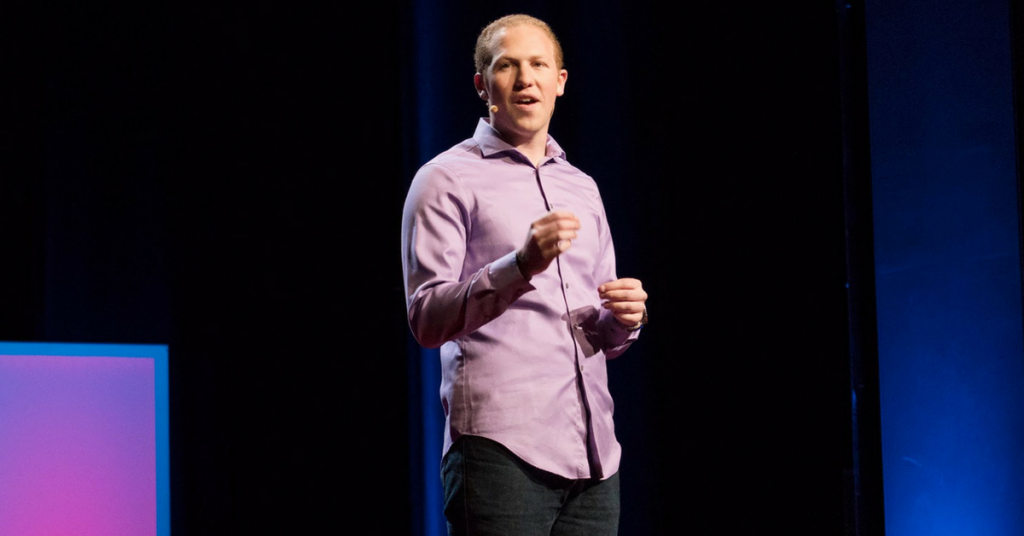
Ever wondered what it is like to meet your favorite social media superstars or interview your favorite startup founders? What if you could meet almost anyone you wanted and spend hours learning about their ideas, business-building strategies, and life stories? We caught up with entrepreneur, TED speaker, and award-winning author Jared Kleinert last year as he was interviewing contributors for his new book 3 Billion Under 30 and asked him to document “a day in the life” in order to learn firsthand how he’s been able to become USA Today’s “Most Connected Millennial” and “The Most Connected ‘Kid’ You Don’t Know (But Probably Should)” according to Inc. We see our favorite personalities on YouTube or Instagram, or obsess over new startups and try to meet them for coffee, but to no avail. Sure, it would be cool to get a selfie with these people or include them in your snap story, but what if you could make friends and do business with them? Jared has, and by following him, we can learn to do the same ourselves.
[Enter Jared Kleinert]
At 10 a.m., I walk up to the Hyatt on 45th street and meet Jason Liebman, of the producers of my new web series, Stories From The 3 Billion Under 30 (whose co-producer is Roberto Blake, a well-known creative entrepreneur and social media influencer). We are here to interview Furious Pete, a YouTuber who has over 5 million subscribers as well as an entrepreneur, sponsored bodybuilder, competitive eater, world record holder in multiple categories, author, TV show host, and cancer survivor. We go up to the 20th floor and enter Pete’s hotel room, chatting with his fiance Melissa who is about to (bravely) take on Times Square in search of coffee while we record two interviews – one to include Pete in my next book and one to include him in the web show.
The day hasn’t even started yet and I’m already humbled. After this, we have interviews with a VC-backed startup founder, co-founder of a non-profit impacting over 50,000 high school students across seven cities, one of the most connected individuals in the business world who runs an event series that is harder to get into than Harvard, the head of a media company with millions of social media followers and tens of millions of monthly unique views on their website each year, and dinner with a good friend and well-known Instagram influencer making over $50,000 monthly from her “side hustle”.
Back to Furious Pete, we spend the next ninety minutes reflecting on his story – from overcoming anorexia when he was younger to his work, lifestyle, and even the German TV show he hosts despite only speaking English and coming from Polish descent. We laugh over my eggs-and-pancakes-themed socks and exchange a furious fist bump in between interviews. All it took to get access to this social media influencer was an introduction from a mutual friend and a ten minute phone call beforehand. Now, we were becoming friends in the moment and finding new ways to help one another. He even pulled out his camera as we walked out and caught footage for his vlogs, which as a stand-alone YouTube channel has over 500,000+ subscribers. I’m just happy I shaved this morning.
In the subway back to my office in the Financial District, I send a 30 second video message to happiness researcher and Snapchat influencer Virginia Salas Kastilio, who I’ve already interviewed for the web series and chronicled for 3 Billion Under 30. We met at SXSW while wearing banana costumes and leading the world-record-breaking attempt for most dancing fruit in one place (or something like that). It’s her birthday today, and I make it a point to call people or send a personal message of admiration as much as possible in a world where everyone else resorts to impersonal posts on Facebook. I record and send the video right as we enter the Q train heading downtown and before I lose wi-fi for the next twenty minutes.
Waiting on the 17th floor of Wework as we walk in is Layla Tabatabaie, lawyer-turned-startup founder who is working on three completely different projects right now. She has her investor-backed startup BarterSugar which helps companies trade professional services with one another, TaleMonster, which is still in beta and aims to assist content creators in sharing works of fiction with readers who can “choose their own adventure” and change what they read in real time based on different jump-off points in the story, and Drinking Press which is a podcast covering history and culture through different drinks of choice (so far, they’ve recorded episodes while drinking whiskey, picklebacks, and Soju, a Korean spirit which is currently one of the most popular drinks in the world).
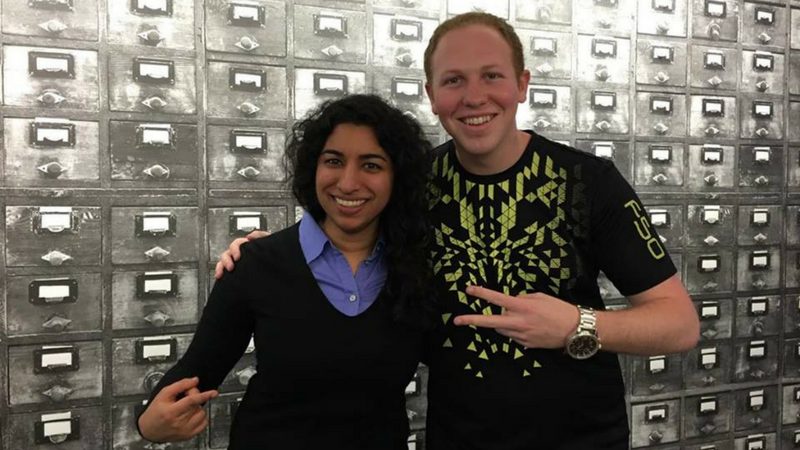
photo by Liebs Media
We need to be finished with our interview at 1 p.m. in order to travel back uptown to interview Kanya Balakrishna, the co-founder of The Future Project who was introduced to me by a professor and researcher at the University of Pennsylvania. He, like global bestselling author Tony Wagner, Sir Ken Robinson, Cleveland Cavs owner and billionaire Dan Gilbert, Alicia Keys, Deepak Chopra, and others support this nonprofit, which works with over 50,000 students in schools nationwide to help them identify projects they can work on to help them see a brighter future, and so I’m really excited to interview her both for the book and for the web series we’ve been shooting all day (we record episodes in batches, typically each Thursday).
We wrap up, share big hugs with Layla, and grab protein bars from the market downstairs. Considering my newest marketing consulting client is Ample, a 500 Startups company that raised $70,000 on Indiegogo in its first two day and went on to raise over $367,000 in one month for its “meal-in-a-bottle” solution to help people gain optimal nutrition in a rush, I’m already feeling guilty, but alas, the show must go on and we are otherwise going to be late for yet another subway ride.
About a half hour later, we walk into The Future Project offices. Apparently, yesterday was Kanya’s birthday, and so there are signs and pictures of her all over the office with words of admiration from her team and program alum. We’re a few minutes late, and squeezed in a 3:30 p.m. meeting after this, so we only have about forty-five minutes to do two interviews and learn how The Future Project has corralled so much support in such little time.
As we head down the elevator, I check my email to see that New York Times bestselling author Dave Kerpen has just published an article about me saying that I’m “The Most Connected Kid You Don’t Know Yet (But Probably Should)” and sharing my “5 Strategies For Quickly Building An Influential Network”, which are the reasons to why I’ve been running around the city meeting all these incredible people today.
I quickly post the article to Facebook, shout out all the mentors and friends I mentioned in the interview, and retweet some of the comments readers have already shared online. Apparently, my next interviewee Jayson Gaignard has already seen the post and commented on my Facebook status, so the pressure is on!
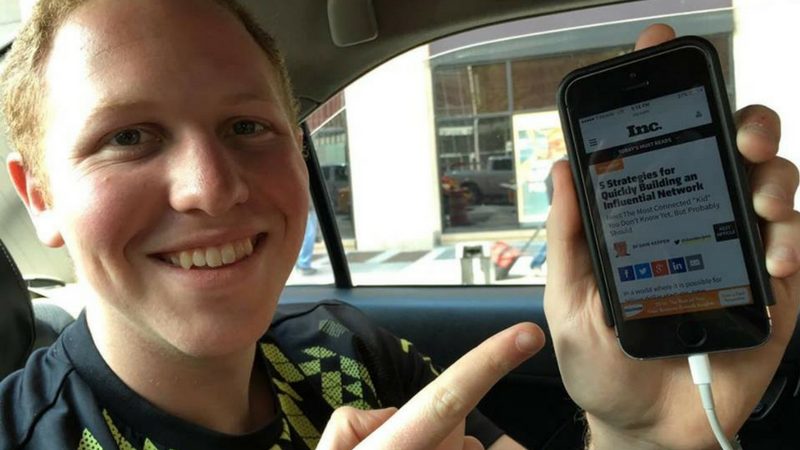
photo by Liebs Media
We enter another hotel near where we had our first interview this morning (why is everyone staying near Times Square?) and see Jayson in the fourth floor lobby. Jayson Gaignard is the founder of Mastermind Talks, one of the most exclusive events each year that hosts thought leaders like Tim Ferriss, Dave Asprey, Gary Vaynerchuk, Lewis Howes, Marie Forleo, and is harder to get into than Harvard with a less than 1% acceptance rate for the thousands of entrepreneurs attempting to get into Jayson’s events.
Much to my surprise, I learn that Jayson is still only 30 (turning 31 next week) and so I offer to include him in my next book, prompting us to dive into two interviews and spend the next hour-plus chatting about how to build super-powered networks. I’m geeking out and am again humbled – Jayson is where I want to be in a decade, running a seven-figure business with a network that influences millions in industries ranging from tech to internet marketing and publishing. This article may as well be a day in his life, but I digress.
We are running over our hour time allotment because we are having fun and sharing so much practical advice with our eventual audiences, and he has a meeting with none other than investor and author James Altucher right after we wrap up.
Ten minutes later, I’m meeting James for the first time (I’ve been a big fan of his work for over a year, and even gave his book Choose Yourself to my mom) and giving my goodbyes to Jayson, a new friend, book contributor, and web show interviewee all wrapped into one.
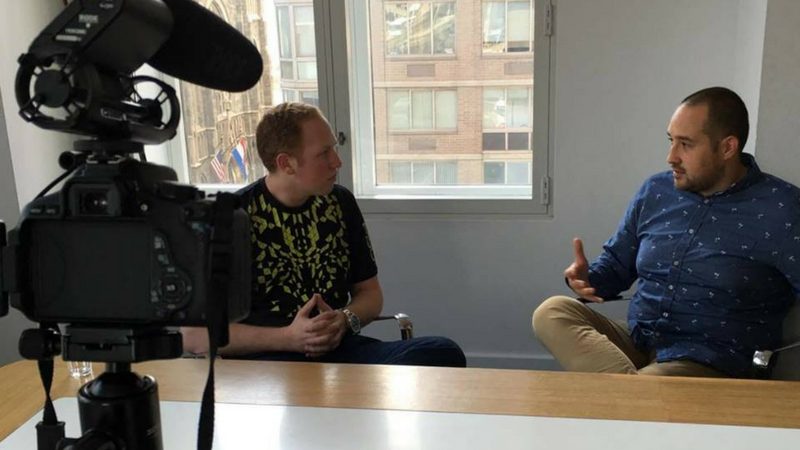
photo by Liebs Media
5:30 pm is when I finally stumble into my office again. The crowd has cleared on this Thursday night and I’m left relatively alone to choose a conference room in which to set up for my next interview, which isn’t until 8:00 pm and is over Skype.
In the meantime I reach out to potential contributors for 3 Billion Under 30, the follow-up to my first book 2 Billion Under 20 which was voted the #1 Entrepreneurship Book of 2015. So far, everyone from entrepreneurs running 7, 8, and 9 figure businesses to pro athletes, Guinness World Record holders, venture capitalists, industry-leading designers, corporate intrapreneurs, and others have sent me their stories so I can share them with the world and encourage our generation to act on their passions in life and unite in solving the world’s most pressing problems. Zappos CEO Tony Hsieh called my last book, “a challenge to young people across the globe,” and I’m increasingly getting more excited about 3 Billion Under 30 because it is shaping up to be the blueprint to accepting such a challenge.
Soon 8:00 p.m. rolls around and Joel Brown from Addicted2Success.com hops on the line. In a few short years, Joel has grown his media company to social media accounts that collectively have millions of followers and an annual unique visitor count of over 50 million. I used to write for his outlet, and now get to hear his most recent story to be shared in my book about struggling with TSA to re-enter the country after temporarily leaving the U.S. to head to Mexico for a friend’s bachelor party (he’s here on a six month visa from Australia). I’m glued to the screen as he shares the experience and how we was kept in a deportation chamber for twelve hours because the officers didn’t understand how he makes money online.
40 minutes we wrap up, wave goodbye via video chat, and I walk out to the shared area in our office to see Alex Wolf, a good friend, Instagram influencer, and entrepreneur who is here to grab dinner with me on Stone Street, the famous restaurant strip near Wall Street that fortunately happens to be right behind the building. Alex has grown various Instagram accounts totalling over 260,000 followers and has a business generating over $30,000 monthly that she doesn’t even run anymore (she has since hired a CEO to run the brand BossBabe she became famous for in order to grow a stronger personal brand). Earlier this week she was named one of Fast Company’s “Most Creative People” in business, and so just as I have been all day, I’m just happy to be here. We wrap up at around 10:30 pm and I head back to my office to send out my free daily “Millennial To Watch” newsletter (where I cover impressive peers of mine from all different backgrounds and industries) before heading back to Brooklyn and calling it a night.
Not every day of mine ends up like this, but I’ve set up projects like 2 Billion Under 20 and 3 Billion Under 30 that force me to meet interesting, exceptional talents given that all my work revolves around identifying, befriending, and connecting top-performing Millennials so I can help educate companies about how to best engage our generations and educate the public about why young people hold more power today than ever before.
I share this not to impress you, but to impress upon you that you too can create these connections and build a network that wants you to be successful and values your unique input. If I can build a 100% self-made network like this in less than five years, imagine what you can do if you take the time to develop a career around providing others with as much exposure, support, and rewards for their work as possible.
Help others by bringing awareness to their work and the stories they have to share, and they will certainly help you in return.
You may like
Business
Top 10 Best Places to Buy a Mid Century Modern Office Chair
Published
2 weeks agoon
July 4, 2025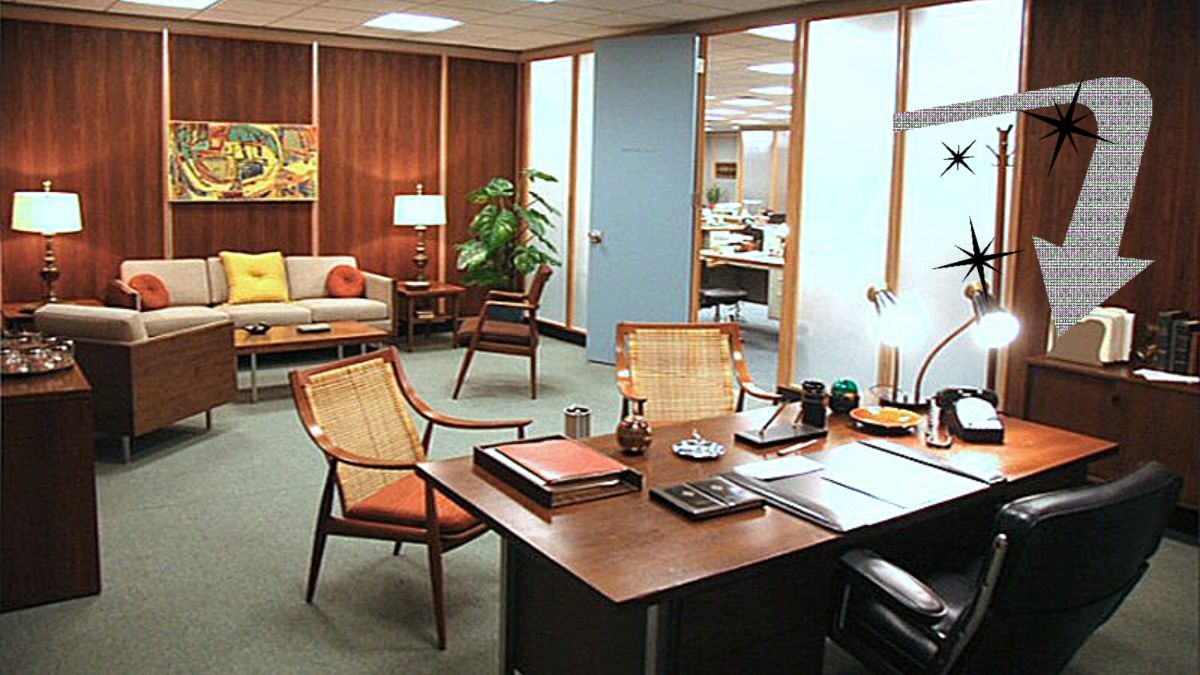
What was once old is new again: mid century modern is back in style. From architecture to furniture, the postwar look is in, and the hype extends all the way to office chairs.
Do you need a mid century modern office chair in your life? If so, there’s plenty to choose from. Your office chair should be tailored to your style, whether you like luxury, utility, or something in between.
That’s why we’ve put together our 10 favorite places to find your ideal mid century modern office chair.
What is mid century modern design?
After World War II, spirits were high in the US, and new technology was taking the country by storm. Mid century modern refers to the design concepts that came about during this time.
As opposed to the frilly, ornate designs of classical furnishings, mid century modern designs are angular, material, and functional. Wood is a common design element, especially teak. Mid century modern furniture may also have materials like glass, vinyl, and metal. Designs are simple and geometric, with bold accent colors to make them pop.
The mid century modern aesthetic never really went away, but it’s made a noted comeback in recent years. Some have chalked it up to Boomer and Gen X nostalgia, others point to mid-century-set shows like Mad Men and The Marvelous Mrs. Maisel.
Why should I buy a mid century modern office chair?
Mid century modern is the perfect fusion of style and utility. If you want to cultivate an office space that commands respect without being ostentatious, mid century modern is the style for you.
When it comes to office chairs, an MCM one is often made with sturdy wood and vinyl. They combine the ergonomics of a modern office chair with old-fashioned grace.
If you’re concerned with utility and utility only, a more bog-standard office chair may suit you. But a mid century modern office chair is great for someone who wants to wow colleagues with a mature, thoughtful business space.
Where can I get a mid century modern office chair?
1) Wayfair
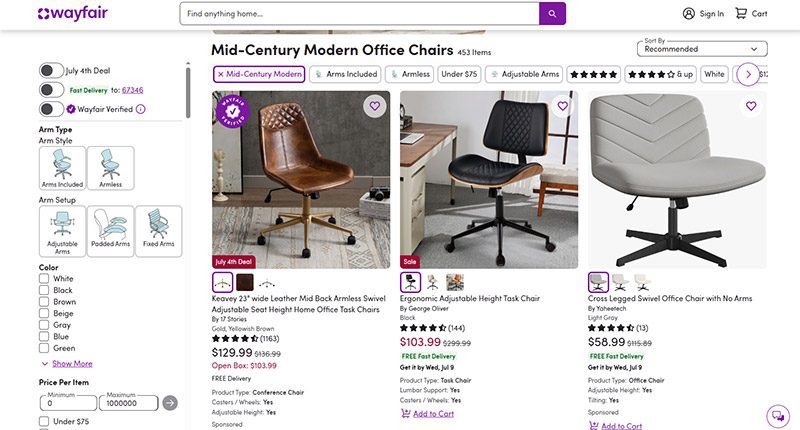
When it comes to furniture, Wayfair offers the best of both worlds. Their goods, including their mid century modern office chairs, are stylish and affordable. You can get a sturdy task chair for less than $100 or a more distinguished seat for less than $350.
MCM office chair examples: Dovray ($126), Bradford ($139), Lithonia ($133)
2) France & Son
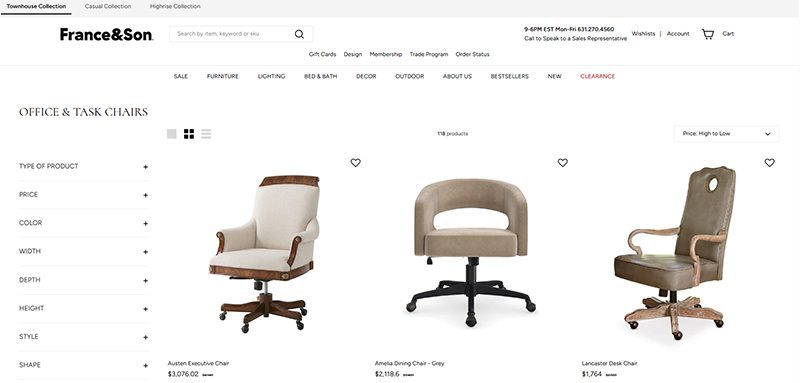
Wayfair’s chairs are affordable, but France & Son is the perfect option for luxury shoppers. Their mid century modern office chairs are robust and sleekly designed. If you dress to impress and enjoy the finer things in life, these are the chairs for you.
MCM office chair example: Brooks ($695)
3) Houzz
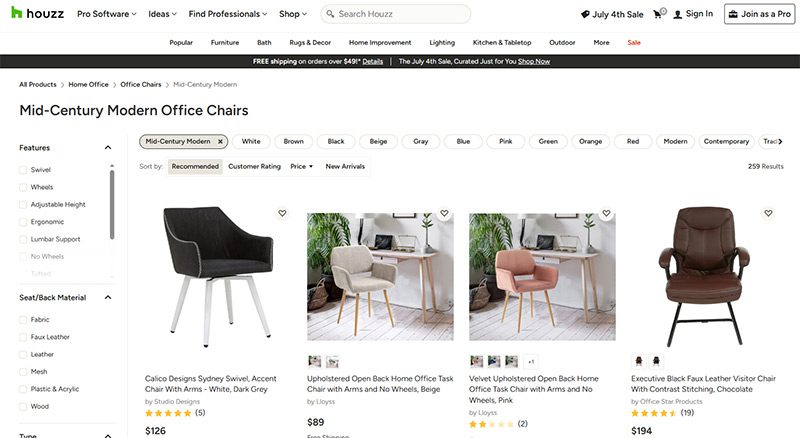
Started as a community for people to share home decor tips, Houzz has become a great ecommerce platform for finding stylish furniture. They’re more known for home decor than desk chairs, but they have plenty of great, affordable finds if you know where to look.
MCM office chair examples: Arvilla ($173), Rathburn ($259)
4) Laura Davidson
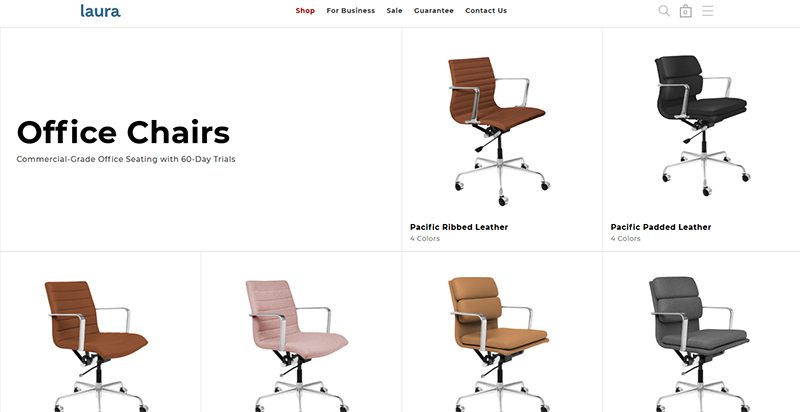
The Laura Davidson collection offers a fairly limited selection of classic office furniture. Still, there’s a reason they’re trusted by big-wigs like Apple, Disney, and Salesforce. Their chairs are sturdy and beautifully designed, reimagining classic Eames and Knoll designs.
MCM office chair examples: Rockefeller ($275), SOHO II Soft Pad ($450)
5) Icons of Manhattan

Icons of Manhattan has a simple philosophy: do one thing, and do it right. Their office chairs are handcrafted from premium materials and tailored to a mid-century modern style. If you want that Mad Men energy in your office (hopefully with a lot less angst), these are the chairs for you.
MCM office chair example: Ribbed Medium ($219)
6) Amazon
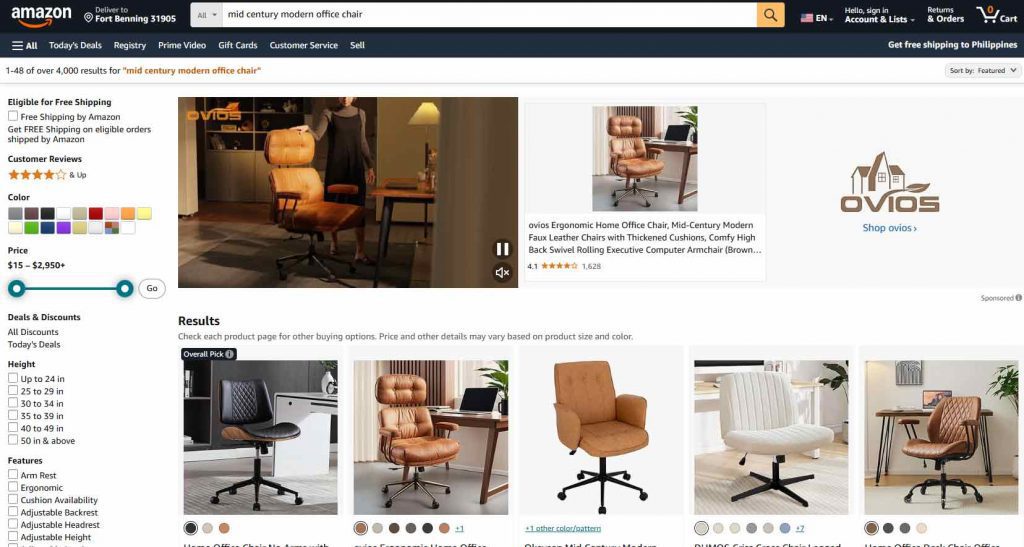
Yes, the internet’s premier shopping destination has a robust collection of mid century modern office chairs. Like with most products, their selection of seats is vast and can be hit or miss. Still, they’ve got stunning chairs available for any style, whether you care about comfort, class, or ergonomics.
MCM office chair examples: IDS Home Modern ($219), Art Leon MCM Swivel ($139)
7) AllModern
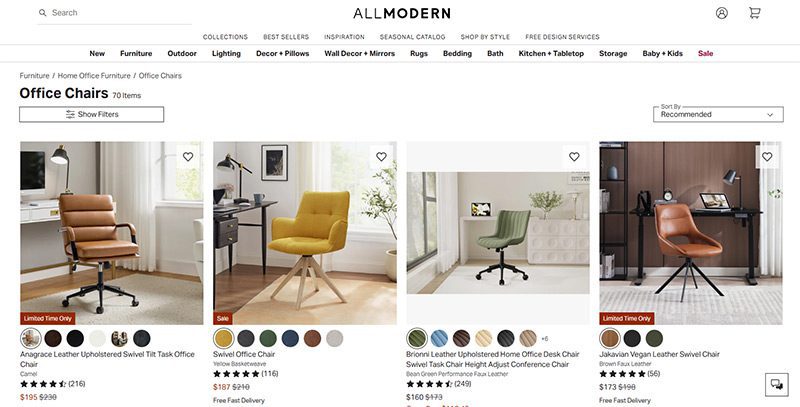
AllModern’s collection of desk chairs and other furniture truly embodies the mid century modern spirit. Their work is tight, angular, and functional above all. They’re part of the Wayfair family and they traffic in a number of modern styles, but their sleek chairs are perfect for any mid century modern space.
MCM office chair examples: Frederick ($229), Kealey ($349)
8) Overstock
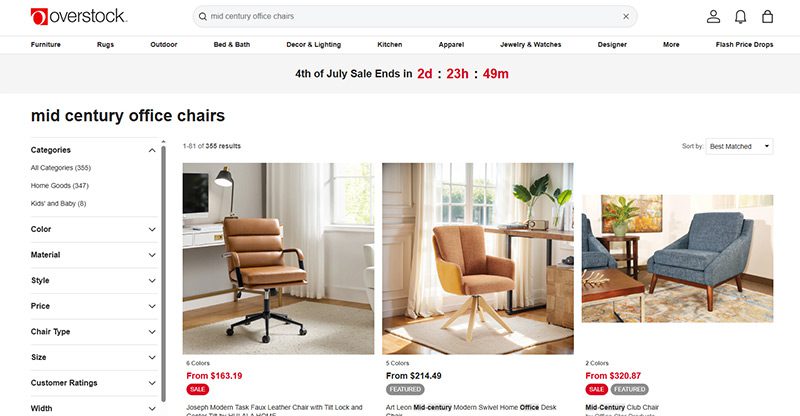
Overstock is known as a one-stop shop for quality home goods at sub-wholesale prices. If you want a spiffy mid century modern office chair that won’t break the bank, they’re the first place to look. While they’re somewhat less reliable than the more upscale platforms on this list, their selection is massive.
MCM office chair example: Joseph Modern ($163)
9) Walmart
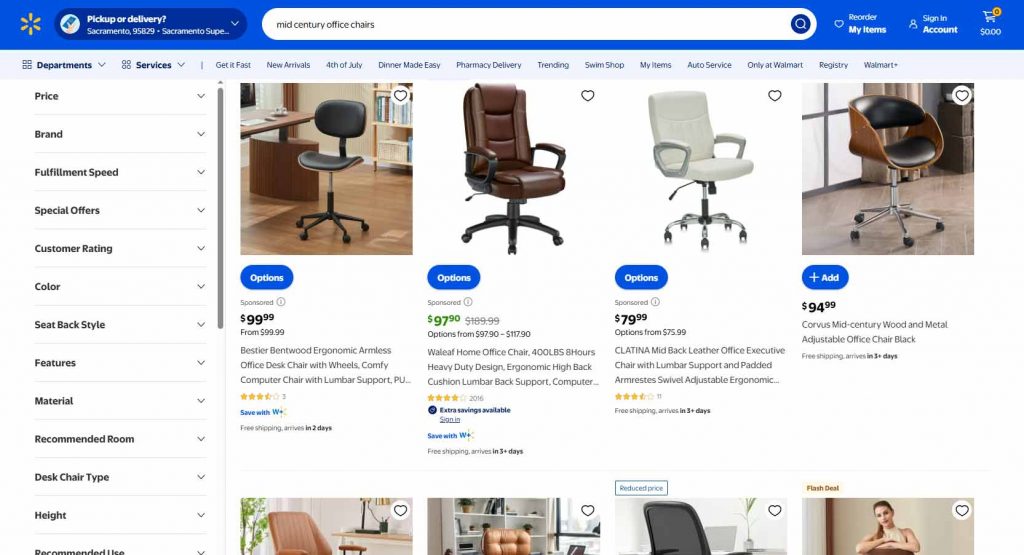
Hayneedle’s selection of mid-century modern office chairs falls somewhere between the minimal Laura Davidson and the endless Amazon catalog. Their array of mid-century designs is affordable and versatile, with chairs that match almost any style. While they may be part of the Walmart family, these chairs are anything but second-rate.
MCM office chair example: Waleaf ($97)
10) Target
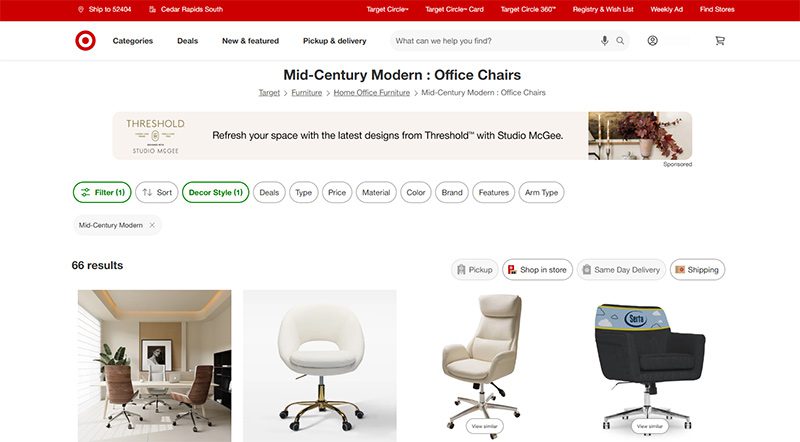
Why splurge when you can save? As usual, Target is a hidden gem, offering a sturdy selection of mid century modern office chairs for some of the cheapest prices out there. Many of the chairs they offer are from the same designers as these other stores—Christopher Knight, LumiSource, Armen Living, etc.—at reduced prices.
MCM office chair example: Lombardi ($136)

A quality payroll service is one of the most invaluable tools any entrepreneur can have. Whether you’re a small business owner or an HR manager, paying your employees on time is crucial. This makes choosing a service even more weighty, after all, it is a heavy administrative burden. The good thing is, you can outsource this duty to an online payroll processor.
According to statistics, 49% of workers begin a new job search after just two paycheck errors, and with 65% of workers living paycheck to paycheck, it’s more important than ever to ensure an efficient, effective payroll process.
These services can save you precious time and mitigate potential issues. To make it easy for you to choose, we listed the best online payroll services for 2025.
Top 5 Online Payroll Services
Gusto
Gusto is a great option for both new and experienced payroll administrators, boasting an incredibly clean user interface and a first-rate payroll setup. Gusto lets you manage your employee’s time off (vacation and sick pay), company health insurance, and worker’s comp. Gusto offers excellent mobile access, too. This allows employees to manage aspects of their Gusto profiles, view payday insights, and access Gusto Wallet financial tools.
Gusto offers four tiers of membership, the most affordable of which is the Contractor’s Only plan, which offers unlimited U.S.-based and global contractor payments, supporting more than 100 countries, plus 1099 creation and filing at a rate of $6 per person per month with no base price.
The other three are Simple, Plus, and Premium. Here’s a deeper look into each plan:
Simple
Price:
$40/mo + $6/mo per person
Plan details:
- Full-service single-state payroll including W-2s and 1099s
- Employee profiles and self-service
- Basic hiring and onboarding tools
- Gusto-brokered health insurance administration
- Employee financial benefits
- Payroll and time-off reports
- Custom admin permissions
- Integrations for accounting, time tracking, expense management, and more
Plus
Price:
$80/mo + $12/mo per person
Plan details:
(All Simple plan features +)
- Full-service multi-state payroll including W-2s and 1099s
- Next-day direct deposit
- Advanced hiring and onboarding tools
- PTO management and policies
- Time tracking and project tracking
- Workforce costing and custom reports
- Team management tools
- Full support
Premium
Price:
Bespoke pricing, reach out for a personalized quote
Plan details:
(All Plus plan features +)
- HR Resource Center
- Compliance alerts
- Access to certified HR experts
- Full-service payroll migration and account setup
- Health insurance broker integration
- R&D tax credit discount
- Waived fees and exclusive pricing
- Performance reviews
- Employee surveys and insights
- Dedicated support
QuickBooks Online Payroll
Founded in 1983, Intuit is a California-based financial software company. Since its inception, Intuit has developed into one of the best-known providers of accounting software. Their online payroll service, QuickBooks, includes the essential features you need to run payroll.
QuickBooks offers three tiers of membership. The least expensive membership covers basic accounting features, such as invoices. For more features, check out the Essentials and Plus memberships. Each plan’s features are as follows:
QuickBooks Simple Start (2025)
- Price: $38/month for 1 user
- Best for: Freelancers and small teams with basic payroll needs
Features:
- Automated bookkeeping
- 5 free ACH bank transfers/mo for bills
QuickBooks Essentials (2025)
- Price: $75/month for 3 users
- Best for: Small businesses needing deeper financial tracking
Features:
- Includes all Simple Start features, plus:
- Recurring invoices
QuickBooks Plus (2025)
- Price: $115/month for 5 users
- Best for: Growing businesses with HR and compliance needs
Features:
- Includes all Essentials features, plus:
- AI-powered profit & loss insights
- Anomaly detection and resolution
- Budgeting
QuickBooks Advanced (2025)
- Price: $275/month for 25 users
- Best for: Established businesses with HR and compliance needs
Features:
- Includes all Plus features, plus:
- Custom user management and permissions
- Custom report builder
- Data sync with Excel
- Revenue recognition
- Forecasting
OnPay
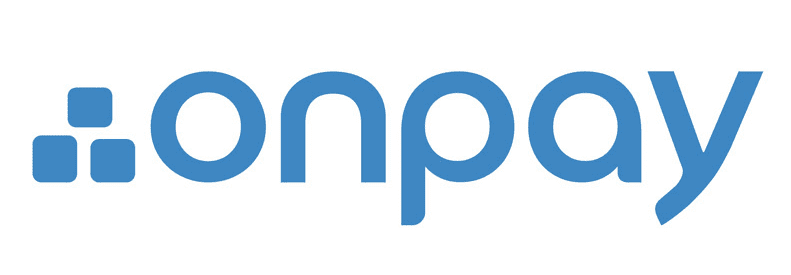
OnPay is a cloud-based full-service payroll processing system capable of running payroll according to a preset schedule, automatically disbursing wages, and calculating and withholding taxes.
OnPay can sync up with several other software your team is already using, making it easy to integrate the service into your team’s system. Another benefit of OnPays model is the simple, transparent pricing structure. No tiers; just one base rate.
Pricing:
$49/mo + $6/mo per employee
SurePayroll

SurePayroll’s award-winning service supports W-2 employees and 1099 contractors. Additionally, it handles 401(k) deductions and manages flexible spending accounts (FSA) and health savings accounts (HSA).
SurePayroll also offers a mobile app— available on both Apple and Android devices.
SurePayroll offers live support through its United States-based support team through chat, email, or phone.
Small Business Payroll
- Price: No Tax Filing: $20/month + $4 per employee, Full Service: $29/month + $7 per employee
- Best for: Small businesses and startups
Features:
- We file and deposit your federal and state taxes!
- Run payroll in 3 simple steps
- Schedule payroll to run automatically
- Unlimited payroll runs and free 2-day direct deposit
- Reports and pay stubs are available online 24/7
- Supports W-2 employees and 1099 contractors
Nanny & Household Payroll
- Price: Full-Service Household, $39/month, includes 1 employee, $10 per additional employee
Best for: Homeowners
Features:
- Signature-ready Schedule H
- We file & deposit your federal and state taxes!
- Run payroll in 3 simple steps
- Schedule payroll to run automatically
- Unlimited payroll runs and free 2-day direct deposit
- Reports & paystubs available online 24/7
- Supports W-2 employees & 1099 contractors
Be sure to choose a payroll service that works for your business, and provides you with the peace of mind that comes with a reliable bookkeeping system. Your employees will thank you.

Merck is currently in talks to acquire Seagen, a biotech company. The Wall Street Journal reports that the transaction is valued at $40 billion. And what happens if Merck acquires Seagen, and how would this acquisition benefit cancer research and treatment? Read more about the Merck Seagen buyout here.
Merck Seagen Buyout
Merck and Seagen are still deciding on their share prices. So far, talks have yet to reach an agreement on $200 per share. Both companies want to settle and finalize their deals before Merck announces its quarterly earnings on July 28. At the time of writing, Seagen’s stock was at $176.19.
With an estimated market value of $235 billion, Merck is looking to expand its presence in the cancer treatment space. The Merck Seagen Buyout could play a major role in that strategy. Since Seagen specializes in targeted cancer therapies, the acquisition would give Merck access to a broader range of oncology products.
Shareholder reactions to the new deal are overwhelmingly positive, and the stocks have been up since talks about the deal have been made public.
But this is not the first time that Merck and Seagen have made the news. Back in 2020, they collaborated because of cancer treatments. Seagen has a drug conjugate (ladiratuzumab vedotin) which would be used in conjunction with Merck’s Keytruda.
Merck reveals that Keytruda is its highest-selling product. It’s immunotherapy for cancer.
And this deal could help Merck offset the possibility of reduced sales because it will lose patent protection in 2028.
As promising as this deal is, there could be scrutiny from antitrust officials since there might be a litigation case from the Federal Trade Commission or Justice Department.
The Seagen buyout isn’t the only deal Merck has made recently. They’ve been busy closing another deal, but with Orion too.
Seagen
As a cancer biotech company, Seagen has therapies to ensure that patients benefit from the treatment and reduce any adverse side effects. Their treatments involve the therapy attacking tumors with toxins.
Merck partnering with Seagen isn’t a bad idea considering that Seagen made $1.4 billion in sales in 2021, most of it coming from Adcetris and Padcev (a treatment for urothelial cancers).
Merck-Orion Deal
In the middle of the Merck Seagen Buyout, Merck has recently partnered with Orion for the ODM-208 and other drugs. These drugs are related to the production of steroids. Orion found how it can combat hormone-dependent cancers and further developed this inhibitor.
Their deal includes that they should develop ODM-208 and promote it to the public together. And Orion will receive a $290 million payment from Merck.
Although they’re co-developing and marketing the new inhibitor, Orion will oversee the manufacturing side.
Co-developing the ODM-208 can help Merck with its current research and treatments for prostate cancer. President and CEO of Orion, Timo Lappalainen, says that this partnership will benefit Merck’s goals of treating cancer worldwide.
Other Ventures: Merck’s Role in the Pandemic
You may have heard about COVID-19 pills, which are a form of treatment for those diagnosed with mild to moderate COVID-19. Merck introduced an antiviral COVID-19 pill to the public. The name: Molnupiravir.
The COVID-19 pill is not a replacement for a vaccination. Instead, it stops the replication of the COVID-19 genetic code and keeps the patient out of the hospital. Not yet FDA-approved, Molnupiravir has been authorized for emergency use since December 23, 2021.
And for other stories, read more here at Owner’s Mag!

What Is Tiktok Pink Sauce? The Viral Condiment, Explained

Did You Drop Your Smartphone in The Ocean? Here’s How to Retrieve It

Gift Guide: 25 Best Gifts for Women for All Occasions

History of the NBA: The Success Behind the Big League

Demio SaaS 2025 Review: Features, Pricing, Pros & Cons

Top 12 Uses for The Metaverse That Will Change Your Life

Top 10 Best Places to Buy a Mid Century Modern Office Chair

Top 10 Best Places to Buy a Mid Century Modern Office Chair

History of the NBA: The Success Behind the Big League

8 Best Equipment for YouTube Every Content Creator Needs

Demio SaaS 2025 Review: Features, Pricing, Pros & Cons

Did You Drop Your Smartphone in The Ocean? Here’s How to Retrieve It

Top 10 Small Business Organization Tools for 2025

Top 12 Uses for The Metaverse That Will Change Your Life
Trending
- Entertainment4 days ago
History of the NBA: The Success Behind the Big League
- Reviews4 days ago
Demio SaaS 2025 Review: Features, Pricing, Pros & Cons
- Lifestyle3 days ago
Did You Drop Your Smartphone in The Ocean? Here’s How to Retrieve It
- Lifestyle4 days ago
Gift Guide: 25 Best Gifts for Women for All Occasions
- Top Stories3 days ago
What Is Tiktok Pink Sauce? The Viral Condiment, Explained





